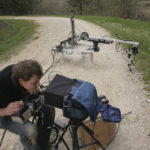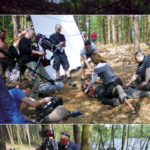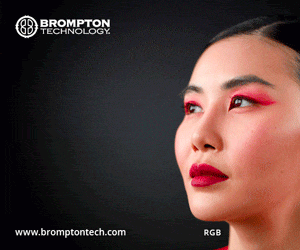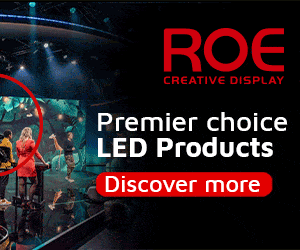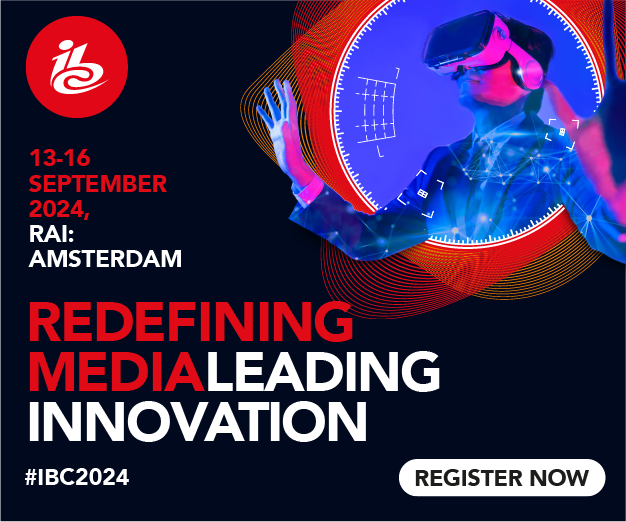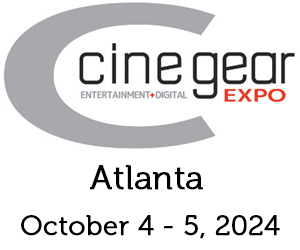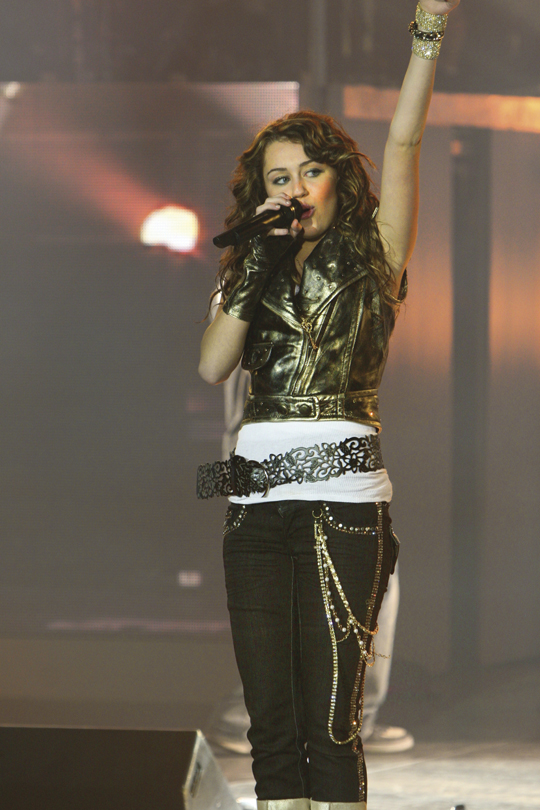
How To Shoot A Concert In 3D – Conversations From Another Dimension
Posted on May 10, 2010 by Alex Fice
Disney Channel favourite Miley Cyrus and her alter-ego Hannah Montana may just have kick started a multi-million dollar new industry into life with the recent ‘Best of both worlds’ 3-D concert film. After pulling in nearly $30million in its US first weekend alone producers are eyeing up future 3-D opportunities. Executive Producer Vince Pace talked to 3-D Guru Phil Streather about how the concert was creatively and technically shot and postedThere is a little part of Los Angeles called Burbank which manages to have two of the world’s three most prominent authorities on making 3-D HD, the other one is only a few miles away in Van Nuys – they are Pace, 3ality and Paradise FX.
3ality is a company you may have already heard of as they were the acquisition and post company involved with U2 3D the only other digital 3-D concert film and one which has not earned nearly as much as Hannah Montana.
Paradise FX were heavily involved with a digital 3-D film called Dark Country interesting for the fact that it was shot with two RED ONE cameras when that camera wasn’t doing a lot.
The Hannah Montana concert film had one thing which U2 couldn’t replicate, she had just come off a 54 date US tour and her stock was high in the public eye especially the 10-15 year old variety.
The idea was to shoot a couple of the concerts and then post produce as quickly as possible for release early in the new year.
Vince Pace was recruited for the acquisition but ended up Exec Producing the show, more of that later. First Vince recalls how Miley and her people saw the concert going.
Vince Pace: “They didn’t know that the 3-D success story was already there. Miley as an individual and her manager were saying ‘Oh great! You want to do this 3-D movie – but step back while we do our concert’. Picking up some of those moments in the concert were just great. She was giving those looks to whoever was there. I made a comment when we were posting that this really isn’t about the 3-D, this is her singing her ballad about her grandfather on the track Missing You and stuff like that. So it’s really not about the 3-D. When I watched the song, I said to myself ‘It’s all about the 3-D’, when she ends that and sings that last note, she’s right there. It was all about the 3-D because she just looks so real being there, saying something.
Phil Streather: The way that you are converging on that Hannah shot, in fact, virtually everything that is remotely interesting is in front of the screen. Just by a little bit. You know, it’s bulging! It’s got this presence and then every now and then someone throws a guitar pick – I thought that this drum stick bounce was very cool.
Vince Pace: That was interesting also for me because I’m the guy who shoots realism – right? – and we had that trick and it comes into the camera, then we enhanced it a little bit with our tools. Actually, we always wanted to make it look real, but no, we wanted to make it look fun. It was a carry-over. What we did was we transitioned, so we just hung it a little bit. Because in the slow motion effect we didn’t have all the frames, but it was perfectly done.
Phil Streather: And it looks like a real stick. It almost just about breaks free as well so it’s not too neat.
Vince Pace: One of the priorities because we were servicing the group between 10 and 13 years old was that I wanted the parents to enjoy it too. I wanted the parents to sit there and go ‘Wow, this is fun!’.
Phil Streather: It had as many gimmicks as you’d want. It had a couple of Gibson ends in your face, it had the pick, it had a couple of microphone stands. How many more do you want? One of the other things that I was thinking through the second time I saw it was: ‘Well, half of this is in 2-D! It’s all grainy and probably shot in HD or HDCAM rather than SR” and then I thought ‘Oh, just a minute! This is actually working because it’s the show that’s the magic’ and then I’m seeing a sort of ‘behind the scenes’ grainy then when I then come back to the 3-D I’m going ‘Wow, this is cool!’ I think this is actually a very interesting way of doing it because you are completely switching them off the 3-D, so they completely recover. It’s not just like a little bit of 3-D where you’re still having to work. You’re giving people’s eyes a complete rest and then you come back to it. I must confess I like that.
Vince Pace: It showed we could go in different areas. It doesn’t necessarily have to be one way or another. If you really analyse the 3-D, we built at moments, we also try and relax at moments so we’re letting her come down, if you will, so we can build her back up. I wanted a great deal of separation between the moments in 3-D and the moments I wanted to just let the roller coaster come down a little bit.
Phil Streather: How much of the 3-D do you bake-in in production and were you overseeing the edit in terms of ‘z-space’. I noticed that first of her Miley Cyrus songs was about the most aggressive 3-D in the whole movie. So you obviously wanted to make her transition from cinema person to real person. However, that was the biggest negative parallax of the whole show.
Vince Pace: We had to make that statement. We had to say ‘Here she comes. This is a superstar. She is singing, you know, she’s there for you’ and what better way to give her to you than that. It was interesting to say ‘How far do you go?’ As to how I shot it, I really wanted the stage to be the point of interest and let her transition to the foreground. That is how we mapped it out. So track her on when she’s down on the stage, leave it on the stage when she comes towards you. When I got in the post, I took it everywhere I wanted to go. I literally just looked at everything.
I don’t think with the post tools available now you can’t bake anything except for interocular. You don’t want to take into interocular lightly. But it’s not perfect by any means.
I would have loved to have more cameras to be honest with you. We had a long lensing camera which did pay off for us.
Phil Streather: Were there two techno cranes?
Vince Pace: Three. That’s one of the beauties of working with Disney! You had a ‘track Techno’ 50 footer, which can just be anywhere you want it to be. A Techno 30 footer so that could put the camera right on her. Then we had another 15ft techno at the back dancing around. That was for our concert, the real concert where we got the meat of the footage. The next day, we turned it around on the crowd. Because here we are impacting the crowd a little bit, so we are in the crowd but on the next night, we reversed all the seven cameras. There’s some great shots of the techno right behind the drummer. The bulk of the frontage footage was done on one night.
PS: How many camera positions did that mean you had over the two nights?
VP: I think only two or three overlapped, so that meant 11 camera positions and seven stereo rigs.
Rodney (Taylor, one of the DPs for the concert) was great. In the mix, some of those shots when she just comes down or she does that nice little turn – that was Rodney entirely.
PS: Because he’s a sports photographer and a wildlife photographer, he treats her as a combination of wildlife and sport. This is an animal here! Rodney was saying something interesting last night when I spoke to him which was when he first pitched up, there was a big emphasis on ‘How can we get a 3-D moment here? How can we make sure that something comes in here?’ Rodney said ‘Hey! Hey! Forget about it. It’s a concert movie. Let’s just film this as an amazing concert movie and the 3-D will look after itself.’
VP: It’s a 3D moment by its very nature. We don’t have to make it anything. We don’t have to script the 3-D moment. The concert by its very nature, the way it was laid out with the big boxes dropping up and down, with the peninsula there, the whole thing. Unfortunately, it just meant that the project suffered from the fact that some people wanted to just make a solely 3-D ‘in your face’ and there is something to be said about that. But if you were to just shoot the concert in 3-D it had everything that it needed. That doesn’t mean that we didn’t want a steadicam on the stage, a proximity that’s good for 3-D and all that stuff… but nobody had to ‘force the hand’ and if you look at some of the moves, they would say ‘never do that in 3-D’.
PS: Whip-pans! I was wondering on a strobing level, are your cameras 30p rather than 24-25?
VP: 24.
PS: 24p. Why didn’t it strobe?
VP: Because you have to make the pan quick enough so you’re not judging it. In my opinion, when people say you need to slow down 3-D; you need to make it faster! You either got to be fast or give it time.
Fast disregards everything – right? – and just locks on. People get stuck in this: ‘No, no, you’ve got to watch your panning speed”. Mitch (Admundsen – Cinematographer for the concerts) blew that wide open. Mitch was like ‘Rock ‘n roll!’ and Rodney was on the same page.
It’s a matter of making it quick enough so you are not taking in the information for its value. I think that from the way this was approached, positioning of cameras was a critical factor. What we didn’t have for Hannah Montana – and I knew this going in – was 60,000 people. 60,000 for 3-D makes any concert good. You know what I’m saying? In other words, when you see those shots of U2 with bouncing people and everybody in unison and all that stuff, we didn’t really have that. We had a lot of little kids with their parents. We didn’t have the aura of say a Bono.
PS: But there seemed to be a lot more miniaturisation in the U2 film than in your film. So whether you just thought ‘Well, I’m going to zoom in and I’m not going to pull them out to get the volume. I’m going to run with a little bit more cardboard than I am with miniaturisation’.
[The cardboard cut-out effect is a result of using long lenses at the normal interocular. Objects at the same distance from the camera/viewer look like flat planes with stereo space between them]
And if there was a little bit of cardboarding then it didn’t really bother me because cardboarding is only a description of an effect. It doesn’t say it’s bad!
So in terms of you being an Executive Producer on it, was it just a complete buy-out with Disney or are you on some sort of piece?
VP: No. It was a buy-out with Disney. It was a way for them to just ask me to be with the project throughout it’s range and I’m glad I did it. I really do because I’m proud of the project. It could have gone many different ways from a 3-D perspective.
To be honest with you, I appreciate the fact that they involved me to the degree that they did. I really do. They didn’t have to do that. I think Pace played the role with crewing it and teaming up the people.
PS: When you say ‘play the role’, did you choose the seven camera teams?
VP: Mitch picked the operators. We picked all of the core people to support those cameras and then it grew from there because Mitch really wanted to do it film-style. So Mitch definitely was the connection of the operators and I didn’t get into that because, to me, I want the best damn 2D guy you can find. That’s what I want.
PS: Say then on Rodney’s camera, was Rodney bearing anything in mind in 3-D or was it just like: ‘One rule, don’t let things break frame at the top and I’ll sort out the convergence. How was he operating on a tech level?
VP: We did the tests. We went to St Louis and shot. We had a chance to rehearse. St Louis was one of her first concerts in fact, that’s where she opened. So we went there and shot her opening rehearsal. You know what I really like about this situation is that you give me any good 2D guy and you give him a chance to exhibit his craft in 3-D and then look at it. He sees what doesn’t work and was does work for me: they’re not stupid people. A good 2D operator is saying: ‘If I want to frame you right now, what would go onto the print?’ You want him not to lose sight of that. You want him to go in there and do stuff and then say ‘You know what? That looks best for me for operating my camera’, because I want that talent.
That’s what we did and it worked extremely well because they got to see what they were doing and then they realised ‘Hey, that looks really cool that up angle… that looks really awesome’ – you know what I mean? Rodney just built on his own craft as opposed to someone instructing him to say ‘Rodney, you need to do it this way’.
Reed is very – ‘Camera position, camera position, camera position’. He’s always been that way.
Mitch on the other hand is – ‘If you don’t feel it through your images, then you’re doing something wrong’. That’s Mitch. Very much ‘make it happen’, those whip pans he’s not afraid of. For Mitch, it doesn’t work if you’re not in sync with what’s happening.
PS: As Director of Photography, did he design the look and then talked to the Rodneys and Reeds about applying that look? He’s credited as DP on the show so how then did he work with Rodney and Reed?
VP: I think he worked in the same way with what they did for ‘Shining light on the Stones’. You just wanted a lot of isolated people that are going to go in there and rip the heart out of this thing, right?
PS: Was it choreographed? Was someone controlling them through a headset saying ‘Ok Rodney, back off now because we’re about to cut from a wide to you so get in’.
VP: They tried a little bit to time it but these guys are entertainment shooters. These were filmmakers.
PS: So basically, Rodney is there saying ‘Okay. This is what I’ve got in front of me, at any one moment this is the most interesting thing I’ve seen’.
VP: He knows that playing that crowd in front can work really well sometimes, playing it really tight, he just went with the flow. That’s why Mitch I think put a lot of faith in these guys when he said ‘You see the variety of shots. Get me some variety!’ Also, again, that contributed towards it not looking like a pre-staged storyboarded thing.
PS: There is a debate between some DPs saying that the 3-D element needs to come under the control of the camera department. On the movie Dark Country, apparently there was a bit of a dislocation between the camera department and the 3-D department. How did you work as stereographer with Mitch?
VP: I think he listened to my concerns. We discussed it all, but we never dictated. Everybody listened. I am in a little bit of agreement that whether it’s 3-D or 2D, it is a camera department. It is not 3-D v 2D. You need a good DP and somebody that can help put a hand into the 3-D process.
Mitch picked DPs, not operators. You know what I mean? He wasn’t threatened by me coming in, or Rodney or Reed at all. Mitch definitely works in an environment that is ‘Let’s talk about it’.
PS: Did Mitch take one of the cameras?
VP: Absolutely. Primary camera, right at the thrust.
He was the techo crane. He started on a 15ft and I think he ended with a 50ft.
I’m a tremendously serious guy on set. I look at this as a war zone. We’re going to take that mountain. We’re going to go there and I don’t accept defeat. For instance just to give you an ideas where it paid off for me.
The day before the concert we heard the stage was coming in the next day. They were going to build it there so none of our cameras could be on the floor the day that the concert was going to happen! It was coming in overnight from Denver, it was going to land and they had the whole floor to work on. Right? And they were going to erect the stage. They would give us access at 5pm to deploy cameras with the gig starting at 7pm!
I am thinking ‘that’s best estimate of 5pm, that’s the earliest it’s going to be. So I’m thinking ‘Man, this is not the way I thought we were going to do this.We’d be there, the stage would be there, we’d have one rehearsal night and everything’. This was not rehearsal. This was the only concert we were gonna get. So, the night before, we’re there; but the stage hasn’t arrived, it’s just an empty arena – right? – and I say ‘We’re building every single system. We’re rolling every single system from each of its stage position to its location and we need to be set up and operational within an hour’. So that means whatever that cable is, whatever that strut. I don’t care what it is, we’ll figure it out then because there won’t be anything missing come the day that we’re going to do this. This show won’t be held up because of us.
That took us until 1am in the morning and I remember the execs walking through. They flew in from the Denver concert on a charter and they’re coming in there, we’re still working. It’s midnight, 12.30, and we’re still working. Everybody was beat, and I’m the only one saying ‘We’re doing this. I don’t care. Don’t tell me we can do this tomorrow. Don’t tell me we can make this happen tomorrow. We’re going to do this’.
The game day for me was the day before. And I said ‘We are not backing out of this. Don’t tell me that you’re missing a cord or someone didn’t bring your power…‘. We finished at 1.30 in the morning and sure enough, the main camera has a problem.
We don’t know what’s wrong with it. It’s jammed, it’s not working. The controls will not operate, they get stuck. I walk over there and I say: ‘Wait a second, the bolts underneath. Take them off. Just take it off the techno crane mount’. They take it off and everything works fine, right? The techno crane guy in St Louis had used washers to ‘back off’ the bolt. Here he didn’t use the washers, and the bolts went right up into our camera and pinned the camera so it could not operate. We wouldn’t have had time to fix that. That system had to be broken down and put back together.
Flavour that with the meeting right before the concert with the director. He calls us in for a meeting and he stands up and he says ‘I want to have fun at this concert. Miley is about having fun. Yes, I know you guys all got your job to do but don’t forget to have fun, that will show in the image’. I’m sitting there ‘What he is talking about fun!’. I realised then that no matter what happened, it was better to just go with the flow than to be there like ‘this is a war’. I realised that we shouldn’t be forcing Miley into a box because she’s got her own style.
I mean a ‘for instance’ when they were getting ready for the concert the choreography was terrible. It wasn’t ready. How can she not be ready to go with one hour until she’s on stage! It was my wife that said it: ‘Vince, no matter what you do, the 10 year olds will love it’.
So we can all say we crafted this fine piece of art and all of that. It’s not. We went out there, we shot a concert with seven cameras, two days, a tremendous amount of hard work – tremendous amount of hard work. Then we came back, and we went through a 12-week post period with Disney and that shined, shined, shined. You know, we didn’t force the subject matter, we didn’t polish the subject matter, the best thing about Miley is, when I walked away, I thought she was a really good girl.
PS: Well, I watched Hannah twice in a day. Three hours of 3-D in a day and I had no eye strain. I’ve found U2 quite ‘squirly’ because there is that overuse of dislocated convergence. Then there is also a lot more stuff in post where they were fiddling with it. So you’ve actually got the original constant changing of convergence and whether your picture’s coming towards you; then, if you add on to that another layer, you’ve got a sort of a double curve which isn’t in sync. So these people are getting smaller, they’re pulsing in and out on a size-wise and they’re pulsing in and out in z-space. The whole effect doesn’t make you feel nauseous or sick, I just find it a little bit like I’m on a boat.
VP: U2 could have made $30m if they had just finished it in three months. Take all those fans who couldn’t get to the concert and give them that. That’s how they could have made their $30m in one weekend.
PS: So, in terms of post. It was offline on Avid Adrenaline.
VP: Yeah. When we first started in St Louis it was given to 3ality for post. They contracted Pace for acquisition and I was pitching post with the Quantel system. They knew I wasn’t post facility, they knew I wasn’t a post person and they [Disney] were very up front about it.
3ality gave them their pitch and said they had learned so much from U2 that they were going to put those tools to work on Hannah.
I obviously had a new Quantel product that I was very happy about it, it hadn’t been test-driven on a project so there was some sensitivity there and I shared that sensitivity. So I went to St Louis and shot some material, came back here – 10 o’clock at night. I was supposed to see dailies the next morning. At 10 o’clock at night, I take two songs and adjust all the seven camera angles that we had – over at St Louis, that was four, but we had two nights of the rehearsals. Took all the streams with the Quantel, played all the streams back there and I would switch from one and I’d look and say ‘that looks like a really good shot’, I’d do that, I’d put it in the in point, out point, then drop it in my timeline.
I just sat there for two hours cutting two songs together. I played the timeline and I said: ‘One, I get to see all the camera angles in situ, which means cut together with the corresponding angles, which is much better than looking at – you know – a whole hour of one camera. I get to see how they all balance out. I get to enjoy looking at the picture. Looked great! Made my little convergence adjustments.
Next morning, 11 o’clock, we go to Disney. Everybody is there for dailies. Put in tape number one for show one – you know – first tape. We’re watching. Okay? Second tape for show one, third tape. This is all in 3-D.
Then I go ‘Excuse me? You know, I cut together a couple of songs, you know, and it’s really helpful for me to see the camera angles as they mix together and I think you guys should look at that too because we’re also going to be here a long time watching, you know, five things times a one hour concert: that’s five hours to just sit through tapes because they wanted to look at everything’. They said ‘Okay, let’s pop it in’.
Popped it in, it was the opening song. Bang! There she is. Fireworks go off. She’s right there, front and centre. Everybody got it! They said ‘I love that camera angle, look at this, look at that’. The editor Michael Tronic says “Why do you need me?”. That was sweet of him as the only cut I got right is when the fireworks go off because that’s a real decision maker.
Well, that obviously opened everybody’s eyes that within one day they were able to get something back that gave them the indication of where this music was going and when and where they wanted to be. I told the editor he should take a look at what we’re doing because this is certainly the way to see 3-D for me and helps me with my cutting to know what I’m seeing in 3-D. They were contracted to 3ality and we went back and forth a little bit. I would suspect they weren’t getting what they wanted over there. Michael was going to be set up at 3ality to do his cut over there.
I just resigned myself in their track record, 18 months of post and you want to do this in 12 weeks! I wasn’t supportive of it, but I understood their position. 3ality had U2 in the pipeline and they obviously had been posting 3D material. So go with a company who had done it before.
But Michael saw it, the director saw it, they saw how easy it was for me to create something in 3-D.
The minute you take anything into a proxy state – right – from a 3-D perspective, you have to be very careful about what you are doing. How you are manipulating that data, maintaining its integrity. Or you are looking at stuff that it’s a little bit out of sync. Just slightly, and making creative decisions on that.
We could talk about interframe out of sync – within the frame. I could show you stuff that is within the frame out of sync. The good thing is if you have one frame out of sync you could say ‘let’s slip it by one frame’, it’s when you slip it left and right and it still isn’t right that you’re screwed – and you make creative decisions based on that.
With the Quantel system you’re dealing with native footage and that’s a beautiful thing. You haven’t manipulated that footage and you’re not into a wrapper as with other systems.
So Fotokem who had been doing 3-D stuff on a Pablo system the normal way of compositing – overlaying 50/50 images, that’s a known way. Disney then contracted Fotokem to do it with that add-on to the Pablo system, so they ordered the 3-D add-on.
So, that being said, I get a phone call that says ‘We are moving it over to Fotokem, and because of my knowledge with the Quantel system and my knowledge with 3-D, would I stay on the project through its production life as an Executive Producer to, kind of, hand-hold this through’. I said yes.
PS: Do you think there is ever a potential for ingest into something like Quantel’s SID, the smaller version of Pablo, would you ever see that there would be any point in doing a first cut on SID and then going to Pablo or do you think no, just cut on Avid in 2D and send the EDL over.
VP: No, for me I’d like to see the SID player much more. In 3-D, post starts the minute the camera stops shooting. Don’t sweat it, get a good performance, get a good behaviour, get a great fantastic 2D shot because I guarantee if there was a second camera it’s going to be a great 3-D job, and I’ll prove it.
I want it to be dynamic. I don’t want to lose sight of this motion control mentality, but I don’t want people to be looking at the mathematics of the motion controlling and forget the fact that the subject matter is doing the performance of their lifetime and you’re over here saying ‘You know, I wonder if we’re right here?’.
PS: Who was there from, say, Rodney’s camera?
Was someone racking convergence?
VP: Yes. These was a convergence puller and there was a focus puller.
PS: Who would brief the convergence pullers to do their thing?
VP: I teamed them all up. I treated it like a football game. Sat them all down. I was the coach and I told them what I wanted to do, how I wanted to play it, where I wanted to lead convergence when she was coming out to naturally feel like she’s coming in to the audience. I thought we had a natural presentation for 3-D, I said ‘So, the focus puller can track her but, at times, I want the convergence puller to just stay with the base, if you will, and other times track her’.
I had my own monitor that showed me every one of the cameras with the overlap and I was saying, you know, ‘I need more…, I need that’, you know… So depending on that proximity, depending on whether I was going for the wide master…, but they had base instructions in there. I could see when they were making an error and would caution them on it. In retrospect, I think we wanted more of our own time with Hannah. Initially the way the project was planned, we were supposed to have one concert just for us.
PS: I thought you absolutely got what you needed. There is something about that U2 stuff that you can tell that it’s fake on the ten songs that were done. There is something about the absolute ‘liveness’ and spontaneity and reality of Hannah buzzing off an audience that you would then lose however consummate a performer they are.



